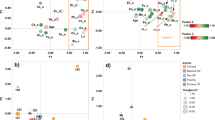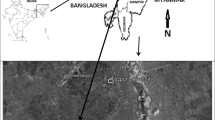Abstract
The objective of this study was to assess worker exposure to mineral dust particles, and a metabolic model, based on the model adopted by ICRP, was applied to assess human exposure to Ta, and predicted values of Ta concentrations in excreta. The occupational exposure to Th, U, Nb, and Ta-bearing particles during routine tasks to obtain Fe-Nb alloys was estimated using air samplers and excreta samples. Ta concentrations in food samples and in drinking water were also determined. The results support that workers were occupationally exposed to Ta-bearing particles, and also indicate that a source of Ta exposure for both workers and the control group was the ingestion of drinking water containing soluble compounds of Ta. Therefore, some Ta compounds should be considered soluble compounds in gastrointestinal tract. Consequently, the metabolic model based on ICRP metabolic model and/or the transfer factor f 1 for Ta should be reviewed and the solubility of Ta compounds in gastrointestinal should be determined.


Similar content being viewed by others
REFERENCES
ACGIH American Conference of Government Industrial Hygienists (ACGIH). (1996). The Threshold Limit Value (TLVs) and Biological Exposure Indices (BEIs) booklet issues ACGIH. Cincinnati Ohio: Technical Affairs office ACGIH.
Ansoborlo, E., Chazel, V., Hengé-Napoli, M. H., Pihet, P., Rannou, A., Bailey, M. R., & Stradling, N. (2002). Determination of the physical and chemical properties, biokinetics, and dose coefficients of Uranium compounds handled during nuclear fuel fabrication in France. Health Physics, 82(3), 279–289.
Australian government—Geoscience Australian. (2014). Accessed January 4,http://www.ga.gov.au/data-pubs/data-and-publications-search/publications/aimr/tantalum
Baily, M. R., Ansorbolo, E., Guilmette, R. A., & Paquet, F. (2003). Practical application of the ICRP. Human respiratory tract model. Radiation Protection Dosimetry, 105(1–40), 71–71.
Bertelli, L., & Lipsztein, J. L. (1987). Mathematical simulation for the study of radionuclide kinetics in the human body. Radiation Protection Dosimetry, 18(4), 209–214.
Birchall, A., & James, A. C. (1989). A microcomputer algorithm for solving first-order compartmental models involving recycling. Health Physics, 56, 857–868.
Blanco, A., Gibb, F. R., Kilpper, R. W., Landman, S., & Morrow, P. E. (1974). Studies of Tantalum dust in the lungs. Radiology, 112, 549–556.
Cardonne, S. M., Kumar, P., Michaluk, C. A., & Schwart, H. D. (1995). Tantalum and its alloys. International Journal of Refractory Metals & Hard Materials, 13(4), 187–194.
Carvalho, S. M. M., Dias da Cunha, K., & Baptista, G. (1988). Particle size distribution of yellowcake. Annual Occupational Hygiene, 32, 870–885.
Chaneliere, C., Autran, J. L., Devine, R. A. B., & Balland, B. (1998). Tantalum pentoxide (Ta2O5) thin films for advanced dielectric application. Materials Science and Engineering: R: Reports, 22(6), 269–322.
Coulston, F., Korte, F. (1975). Heavy Metal Toxicity, Safety and Hormology. Environmental Quality and Safety, Supplement 1. New York: George Thieme Publishers, p.1120.
Cunningham, D. L., (2001). Columbium (Niobium) and Tantalum U.S. Geological Survey Minerals Yearbook. 21.1-21-7.
Dalia Pereira, D. K. C. (2006). PhD Dissertation: Estudo da Exposição Ocupacional a Tântalo e Radionuclídeos Naturais. (in Portuguese) Programa de Pós-Graduação em Ciências Biológicas. IBCCF, Universidade Federal do Rio de Janeiro (UFRJ). Brazil. of Airborne Particulates in Monazite Dust. Nuclear Instruments and Methods in Physics Research. A, 492–494.
Dias da Cunha, K. M. (1997). Contribuição ao Estudo da Exposição Ocupacional ao Tório. PhD Thesis (In Portuguese) Programa de Pós-Graduação Em Ciências Biológicas. IBCCF, Universidade Federal do Rio de Janeiro (UFRJ). Brazil.
Dias da Cunha, K. M., Carvalho, S. M. M., Baptista, G., Paschoa, A. S., Barros Leite, C. V. (1989). Size Distribution of Airborne Particulates in Monazite Dust. Nuclear Instruments and Methods in Physics research section A. Accelerators, spectrometers detectors and associated equipment, 280(2-3)10, 492–494
Dias da Cunha, K. M., Lipsztein, J. L., Azeredo, A. M., Melo, D., Julião, L. M. Q. C., Lamego, F. F., et al. (2002). Study of worker’s exposure to Thorium, Uranium and Niobium mineral dust. Water soil and Air Pollution, 137, 45–61.
Dias da Cunha, K. M., Lipsztein, J. L., & Barros Leite, C. V. (1998b). Occupational exposure to Thorium in two Brazilian Niobium plants. Radiation Protection Dosimetry, 79, 63–66.
Dias da Cunha, K. M., Lipsztein, J. L., Fang, C. P., & Barros Leite, C. V. (1998a). A cascade impactor for mineral particle analysis. Journal Aerosol Science and Technology, 29(2), 126–132.
Eckerman, K. F., Leggett, R. W., & Williams, L. R. (1992). An elementary method for solving compartmental models with time-dependent coefficients. Radiation Protection Dosimetry, 41, 257–263.
Edmunds, L. H, Jr., Graf, P. D., Sagel, S. S., & Greenspan, R. H. (1970). Radiographic observation of clearance of tantalum and barium sulfate particles from airways. Investigative Radiology, 5, 131–141.
Friedman, P. J., & Tisi, G. M. (1972). Alveolarization of Tantalum powder in experimental bronchography and the clearance of inhaled particles from the lung. Radiology, 104, 523–535.
Gamsu, G., Weintraub, R. M., & Nadel, J. A. (1973). Clearance of Tantalum from airways of different caliber in man evaluated by a röentgenographic method. American Review Respiratory Disease, 107, 214–224.
ICRP International Commission on Radiological Protection (ICRP). (2002). Supporting Guidance 3: Guide for the Practical Application of the ICRP Human Respiratory Tract Model. Oxford: Pergamon Press.
ICRP-23 International Commission on Radiological Protection (ICRP) (1973). Report of the task group on reference man. ICRP Publication 23. Oxford: Pergamon Press. Oxford.
ICRP-30 International Commission on Radiological Protection (ICRP) (1979). Limits for intakes of radionuclides by workers. ICRP Publication 30. Pergamon Press, Oxford
ICRP-54 International Commission on Radiological Protection (ICRP) (1989). Individual Monitoring for Intakes of Radionuclides by Workers: Design and Interpretation. ICRP Publication 54. Pergamon Press, Oxford.
ICRP-56 International Commission on Radiological Protection (ICRP) (1989). Age-dependent Doses to Members of the Public from Intake of Radionuclides: Part 1. ICRP Publication 56. Pergamon Press, Oxford.
ICRP-66 International Commission on Radiological Protection (ICRP-66) (1994). Human Respiratory Tract Model for Radiological Protection. ICRP Publication 66. Pergamon Press, Oxford.
ICRP-78 International Commission on Radiological Protection (ICRP) (1999). Individual Monitoring for Internal Exposure of Workers: Replacement of ICRP Publication 54. ICRP Publication 78. Pergamon Press, Oxford.
Kurttio, P., Auvinen, A., Salonen, L., Saha, H., Pekkanen, J., Mäkeläinen, I., et al. (2002). Renal effects of Uranium in drinking water. Environmental Health Perspectives, 110(4), 337–342.
Li, W. B., Wahl, W., Oeh, U., Höllriegl, V., & Roth, P. (2007). Biokinetic modelling of natural thorium in humans by ingestion. Radiation Protection Dosimetry, 125(1–4), 500–505.
Lima, C., Coelho, M. J., Dalia Pereira, K. C., Barros Leite, C. V., & Dias da Cunha, K. (2007). Tantalum dissolution rate in simulant lung fluid. Water soil and Air Pollution, 186, 365–371.
Linsalata, P., Morse, R., Ford, H., & Eisenbud, M. (1991). Th, U, Ra and rare earth element distribution in farm animal tissues from an elevated natural radiation background environment. Journal of Environmental Radioactivity, 14, 233–257.
Lipsztein, J. L., Dias da Cunha, K. M., Azeredo, A. M. G., Juliao, L., Santos, M., Melo, D. R., & Simões Filho, F. F. L. (2001). Exposure of workers in mineral processing industries in Brazil. Journal of Environmental Radioactivity, 54, 189–199.
Llamas, R., Ortiz, J., Perz, A. R., & Baum, G. L. (1969). Experimental bronchography by tantalum insufflations. Chest Journal, 56, 75–77.
Machlin, L. J., Pearson, P. B., & Denton, C. A. (1952). Relative toxicity of Lanthanum, Tantalum and Thorium compounds in the developing chick embryo. Archives of Industrial Hygiene and Occupational Medicine, 6, 441–444.
Matthay, R. A., Putman, C. E., Gee, J. B. L., Walker, S. G. J., Mccloud, T., & Greenspan, R. H. (1977). Tantalum Oxide and Alveolar macrophage function. Investigative Radiology, 12(3), 292–294.
Metzger, R., & Cole, L. (2004). Solubility characterization of airborne Uranium from a recycling plant. Health Physics, 87, 89–91.
Nadel, J. A., Wolfe, W. G., & Graf, P. D. (1968). Powdered Tantalum as a medium for bronchography in canine and human lungs. Investigative Radiology, 3, 229–238.
Nascimento, J.E.C. (1994). Método Para A Estimativa De Doses Internas em Trabalhadores e Indivíduos Do Público. PhD thesis (in Portuguese) Programa de Pós-Graduação em Biociencias nucleares. Instituto de Biologia da Universidade do Estado do Rio de Janeiro (UERJ).
Patocka, J., Kassa, J., Stetina, R., Safr, G., & Havel, J. (2004). Toxicological aspects of depleted Uranium. Journal of Applied Biomedicine, 2, 37–42.
Pietrzak-Flis, Z., Kaminska, I., & Chrzanowski, E. (2005). Uranium isotopes in public drinking water and dose assessment for man in Poland. Radiation Protection Dosimetry, 113(1), 34–39.
Scapolant, S., Ansoborlo, E., Moulin, C., & Madic, C. (1998). Uranium (VI)—transferrin system studied by time—resolved laser—induced fluorescence. Radiation Protection Dosimetry, 79, 505–508.
Sill, Claude W., Voelz, George L., Olson, Dale G., & Anderson, Jesse I. (1969). Two studies of acute internal exposure to man involving Cerium and Tantalum radioisotopes. Health Physics, 16, 325–332.
Skrable, K. W., Chabot, G. E., French, C. S., Wrenn, M. E., Lipsztein, J., Sasso, L. T., & Durbin, P. W. (1980). Blood organ transfer kinetics. Health Physics, 39, 193–209.
Smith, G. C., Stitick, F. P., & Proctor, D. F. (1976). Tantalum bronchography in the radiologically occult cancer. American Reviews On Respiratory Diseases, 113, 119–121.
Straddling, N., Hodgson, A., Ansorbolo, E., Berard, P., Etherington, G., Fell, T., Rance, E., Le Gue, B., (2002). Industrial Uranium Compounds: Exposure Limits, Assessment of Intake and Toxicity after Inhalation. Report number NRPB-W22, National Radiological Protection Board. 118 p.; ill. (chiefly col.); 30 cm.; pbk; ISBN 08-595149-3-5; Available from British Library Document Supply Centre- DSC:9091. 900(NRPB-W22); Country of input: International Atomic Energy Agency (IAEA); Includes bibliographical references.
WHO (World Health Organization) (2001). Depleted Uranium: Sources, Exposure and Health Effects. Department of Protection of the Human Environment. World Health Organization, Geneva, April 2001. World Health Organization.
Yen-Huei Hon; Jian-Yih Wang and Yung-Ning Pan. (2003). Composition/phase structure and properties of Titanium-Niobium alloys. Materials Transactions, 44(11), 2384–2390.
Zahr, J. H. (1999). Biostatistic Analysis (4ª ed.). New Jersey: Prentice Hall.
Acknowledgments
The authors would like to thank Mineração Catalão de Goiás for the support during the sample collection and CNPq and PRONEX for financial support. This work is in memoriam to Prof. Carlos Vieira de Barros Leite, Physics Department PUC-Rio, Brazil.
Author information
Authors and Affiliations
Corresponding author
Rights and permissions
About this article
Cite this article
da Cunha, K.M.D., Dalia Pereira, K.C., Guimarães, J.R.D. et al. Study of worker’s exposure to Tantalum-bearing particles in a mining and metallurgical plant. Environ Geochem Health 40, 2037–2048 (2018). https://doi.org/10.1007/s10653-016-9849-6
Received:
Accepted:
Published:
Issue Date:
DOI: https://doi.org/10.1007/s10653-016-9849-6




